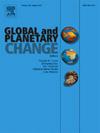High- vs. low-rate of sea level change fluvial floods: Past analogues for future forecast
IF 4
1区 地球科学
Q1 GEOGRAPHY, PHYSICAL
引用次数: 0
Abstract
Projections based on the Intergovernmental Panel on Climate Change scenarios predict a clear rise of the sea level in the near future, together with a decrease in frequency and magnitude of fluvial floods, which are one of the main sources of sediments for some coasts, as response to a decrease in rainfall.
We present a fluvial flood series for the last 17,000 yrs. obtained from cores retrieved in a former restricted embayment by using a multiproxy approach (geochemistry, sedimentology, stratigraphy, palynology), with sub-decadal time-resolution. Flood subfacies are defined by their siliciclastic and saline components. Time distribution reveals that fluvial floods controlled sedimentation rates. Comparison against other records of the Southern Iberian Peninsula allows to identify common periods. For the end of the Pleistocene, low frequency floods are associated to Meltwater Pulses or Heinrich events. During early Holocene, there is a noticeable increase in flood frequency, reaching their maximum at the Holocene Thermal Maximum. The mid- to late-Holocene is characterized by a flood frequency clearly lower than the early Holocene one, but higher than the late Pleistocene one.
Millennial scale changes in insolation controlled atmospheric moisture which, in turn, determined evolution of floods. Centennial scale changes in irradiance were responsible of shorter-term flood episodes over moisture changes.
These results do not fully agree with the expected evolution of floods under IPCC projected scenarios, so further research is needed to improve our knowledge about flood behaviour.
根据政府间气候变化专门委员会的预测,在不久的将来,海平面将明显上升,同时,由于降雨量减少,作为一些沿海地区沉积物主要来源之一的河流洪水的频率和规模也将减小。
本文章由计算机程序翻译,如有差异,请以英文原文为准。
求助全文
约1分钟内获得全文
求助全文
来源期刊

Global and Planetary Change
地学天文-地球科学综合
CiteScore
7.40
自引率
10.30%
发文量
226
审稿时长
63 days
期刊介绍:
The objective of the journal Global and Planetary Change is to provide a multi-disciplinary overview of the processes taking place in the Earth System and involved in planetary change over time. The journal focuses on records of the past and current state of the earth system, and future scenarios , and their link to global environmental change. Regional or process-oriented studies are welcome if they discuss global implications. Topics include, but are not limited to, changes in the dynamics and composition of the atmosphere, oceans and cryosphere, as well as climate change, sea level variation, observations/modelling of Earth processes from deep to (near-)surface and their coupling, global ecology, biogeography and the resilience/thresholds in ecosystems.
Key criteria for the consideration of manuscripts are (a) the relevance for the global scientific community and/or (b) the wider implications for global scale problems, preferably combined with (c) having a significance beyond a single discipline. A clear focus on key processes associated with planetary scale change is strongly encouraged.
Manuscripts can be submitted as either research contributions or as a review article. Every effort should be made towards the presentation of research outcomes in an understandable way for a broad readership.
 求助内容:
求助内容: 应助结果提醒方式:
应助结果提醒方式:


